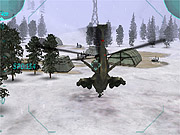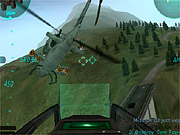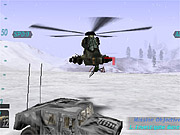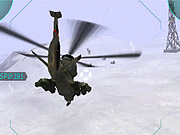Thunderstrike: Operation Phoenix Preview
We spend some time with the next Thunderstrike game, currently going through Core Design's assembly line.
Core Design's portfolio of upcoming games is highly diverse. Aside from the enigmatic (and perhaps slightly mystified) next-generation Tomb Raider, the UK-based studio has both the inspired Herdy Gerdy and the harsh Thunderstrike: Operation Phoenix on its slate. While it perhaps hasn't garnered the high profile of the former two, this latest incarnation of Thunderstrike--which is slated for a PS2 release this September--is probably no less enticing. Essentially, the game dwells firmly in the domain of flight-action, much in the vein of Ace Combat and Air Force Delta. Strange, however, is that the game's experience is being billed as arcadelike. Everything--from the game's control-scheme to the relative complexity of some of its missions--eschews the simple fly-and-blast focus that such a term implies, in favor of something deeper.

Thunderstrike casts you as the pilot of a high-powered rear-rotor chopper, whose mission it is to locate and eradicate the source of a seemingly concerted, worldwide terrorist strike. While that's all that's known about the actual content of the narrative, the stage upon which it'll be set is already pretty clear. As the aforementioned superpilot, you'll gun your way through seven campaigns, each of which will be composed of three to six individual missions. In all, that's anywhere from 21 through 42 scenarios, not counting bonus missions that are unlocked as standard ones are completed.
To guide your gunship through all these hazards, you'll use a control scheme not unlike the "expert" controls found in flight-action games, as far as complexity is concerned. They're centered on the use of the PS2 pad's dual analog sticks--the left stick is for mapped forward and backward movements, and lateral banks (for strafing), while the right stick is reserved for altitude controls. While movement is initially a little difficult, the learning curve is actually pleasantly short: After spending about 15 minutes with the game, we found that even the most precise movements were easy enough to perform. The game's auto-aiming function helps its accessibility a great deal; as you fly through the environments, you'll find that your aiming reticle intelligently toggles between targets, focusing on enemies closest to your space. Moreover, during dense battles, the system seems to lock on to the target capable of the most serious threat to the integrity of your hull. To drive home the nature of the threats, your chopper has built into it an interface that illustrates exactly what it's locked onto: Zero in on a tank, for example, and an image of it will appear on your HUD. This is very useful, as oftentimes it's hard to determine the nature of the threat by examining the projectiles it shoots your way alone. You can also toggle between targets manually, and doing so is often required. This is done by means of the circle button.

More precise shots will often call for an altogether different perspective. Thunderstrike allows for this: During play, you can switch between three different perspectives, specifically a behind-the-rudder third-person view, an inside-the-cockpit view (complete with dangling, math-powered personal effects), and a true first-person view. This is achieved by a simple press of the triangle button. Further, if your assaults require even more precision, you can zoom into any element in the environment, magnifying your perspective to a staggering degree. During an earlier demo of the game, in fact, a Core representative was able to zoom into a single infantryman on the battlefield and pick off his helmet with a shot from the chopper's vulcan. While we doubt that the game will often call for such insane precision, it sure did serve as a good testament as to what its engine can do.
Eidos recently let us play the game at length, and we focused on several of the missions in the game's current build. This let us not only get a feel for the way that game will ultimately play, but it also gave us a chance to see how the game's environments would look and how they'll react with the game's other elements.

The first mission was fairly simple. Basically, our objective was to destroy our enemy's early warning system, by systematically eliminating its central radar and satellite antennae towers. The radar was housed in a heavily armored structure, surrounded by an assortment of missile turrets, manned gunner trenches, and tanks aplenty. Getting to it, though, required us to proceed from our starting point, through a series of hills and trees, throughout which were nestled large amounts of enemy artillery. Picking them off from a distance was simple, however; thanks to the game's smart targeting system, we were able to make several passes with our machine gun and take the villains out without expending much in the way of missiles. While it may be tempting to pile heavy munitions on everything your reticle focuses on, it's often wiser to butter things up with your gun. Its use is pretty limited at this point, however; rather than allowing trigger-happy pilots full use of the weapon, Core has implemented an overheat feature that causes the gun to become momentarily useless after several seconds of extended use. While such a feature isn't inherently bad, the relatively weak power of the gun makes it much less useful than it should be, given the game's pacing. In any event, the gun served their purpose, despite their forcing us to expend more ammo than we feel we should have. We were ultimately able to destroy the enemies surrounding the radar encampment and subsequently take out the control towers that rested on the peripheral hills. We were armed with three types of weapons: standard-issue bombs, lock-on missiles, and unguided rockets. Taking out the heavily armored radar required much heavy bombing, and the interface used for this task is very hands-on. Essentially, the camera shifts to the belly of your chopper, through which you must line the reticle with its target. When you decide to fire, you'll actually see the bombs drop and destroy their target. The effect is very sharp, and the game allows you full control of your chopper all throughout.
The second and third missions were quite a bit different. The second had us chasing, and subsequently disarming, a nuclear weapon that was on a moving train. To do so, we had to destroy each individual car, save for the first. After that, we had to call in a strike force to occupy the remnants of the train. This was accomplished by means of the game's radio-communications interface, which, in the final game, you'll use to both accomplish context-sensitive actions (like this one) and order the wingmen who'll eventually accompany you on your forays. When activated, the menu pops up unobtrusively in your HUD, and you're allowed to select from a series of default commands: attack, cover me, and the like.

The third mission was fairly straightforward: It had us escorting a convoy of supply trucks through a heavily populated route. We basically had to hunt down stationary enemies through the winding, hilly environment and make sure that no mobile threats made it too close to convoy. The topography, in this stage, was particularly impressive: Many hills and bumps permeated the landscape, many of which were very prominent. The sense of scale was amazing, and the level of realism was very inspiring.
Thunderstrike: Operation Phoenix is already looking quite good, especially considering its relatively early state. Eidos is claiming that the game is pre-alpha, though we're not so sure. We definitely feel, though, that once testing on the game begins in earnest, it'll assume a form even more impressive than the one it already bears, as at this stage, the game is superbly playable and visually sharp. It's due out in September, so we'll definitely keep you posted.
Got a news tip or want to contact us directly? Email news@gamespot.com
Join the conversation